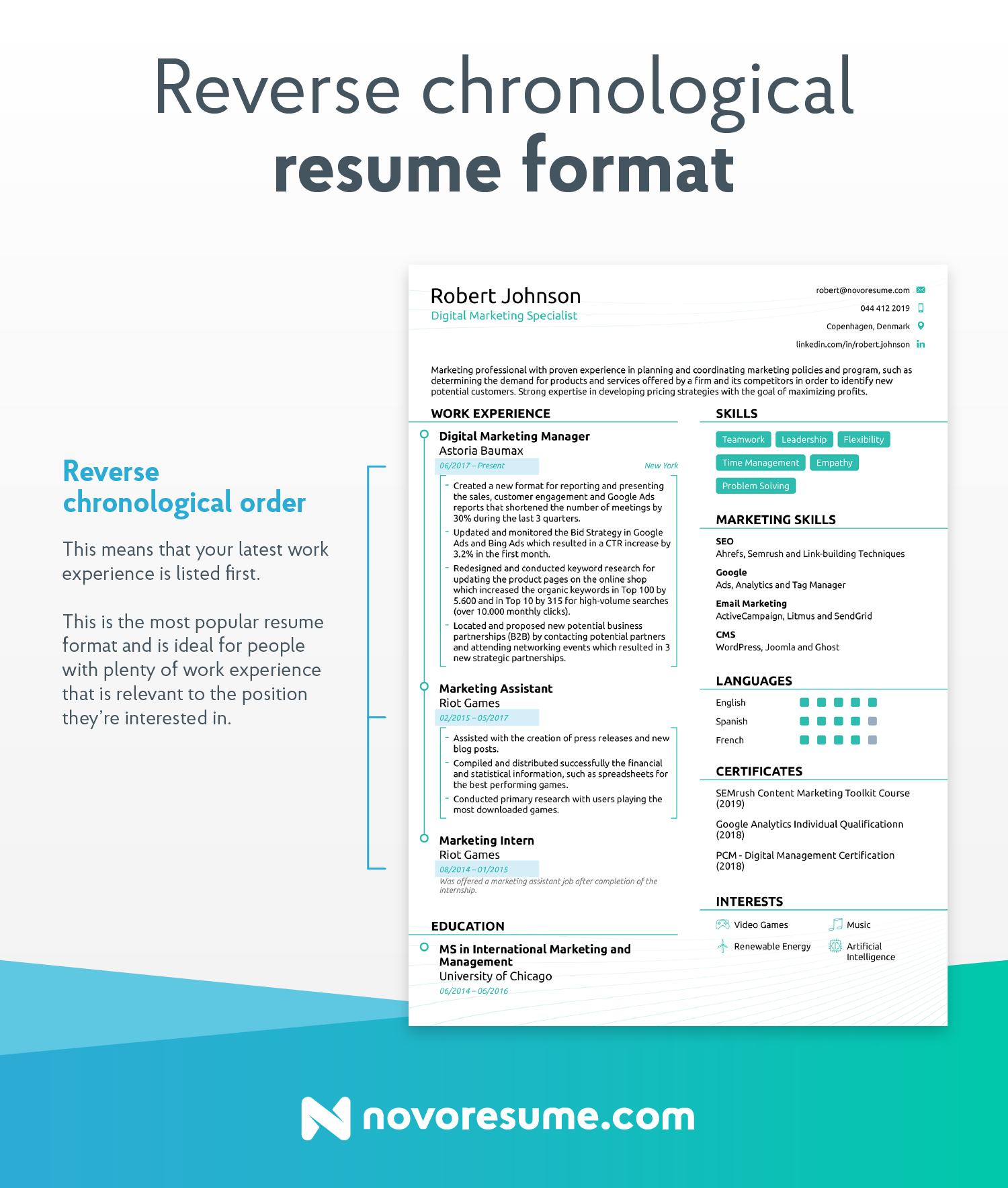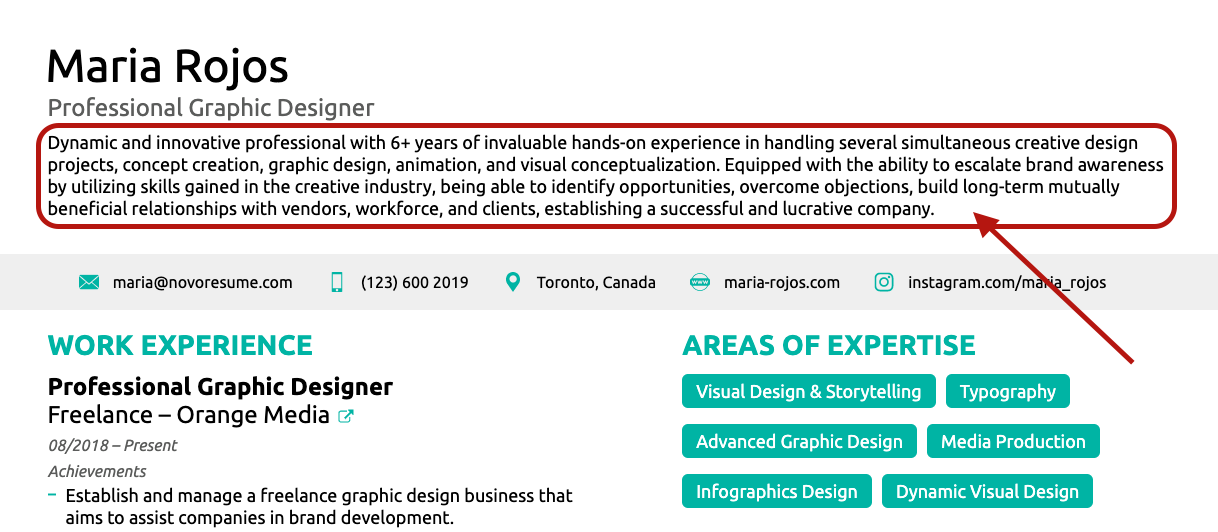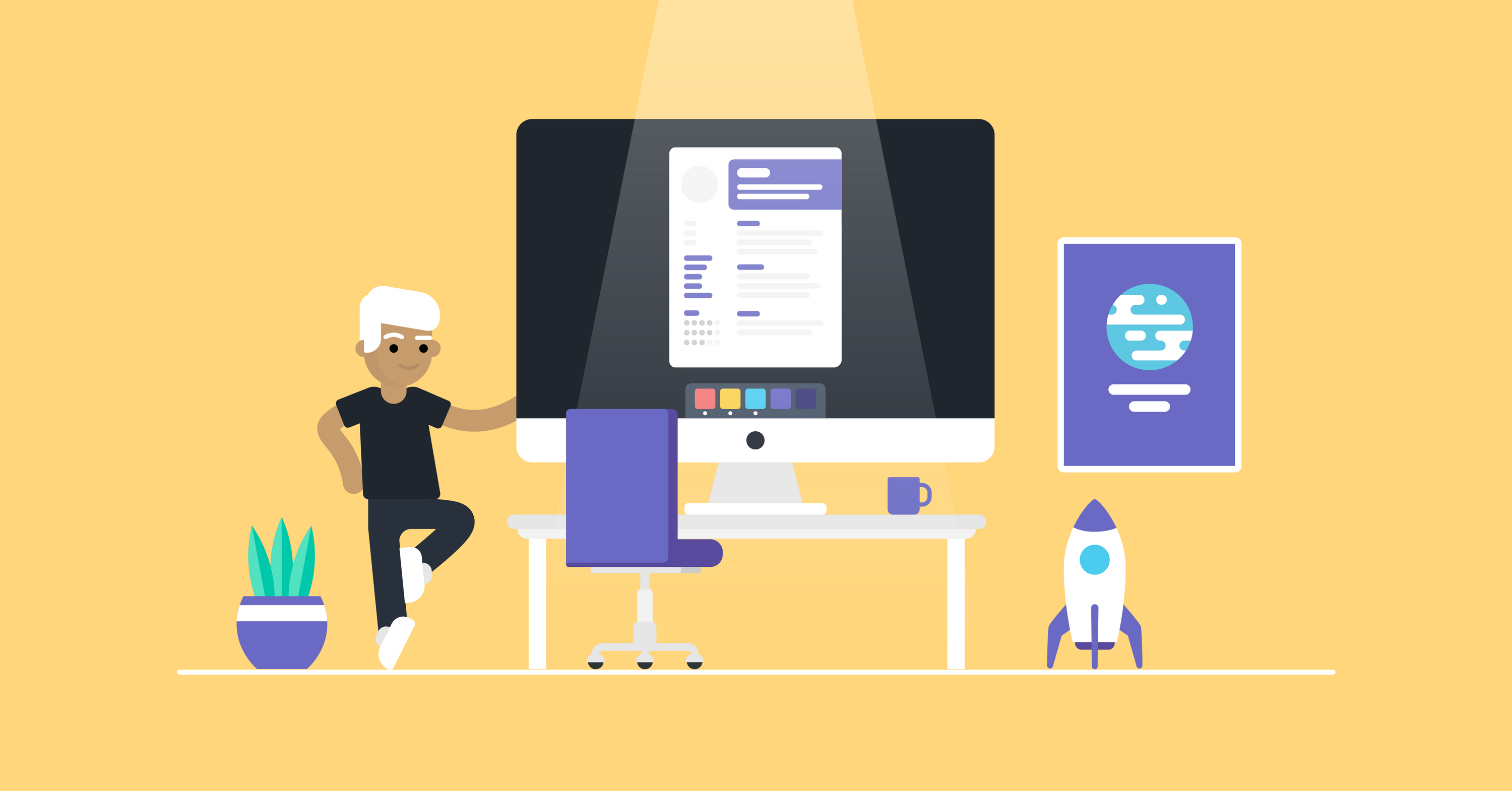You’re a graphic designer. You’re smart. You’re creative.
You design creative ads, product packaging, and websites on a daily basis.
But when it comes to creating a resume, you’re stumped.
How do you make a graphic designer resume, anyway?
Is it exactly the same as a resume for any other profession?
Do you attach your portfolio with the resume? Or do you include the links inside?
There’s a ton of things that are not clear when it comes to making a graphic designer resume, which brings out to this article.
We’re going to walk you through the entire process of creating a graphic designer resume step-by-step!
- A job-winning graphic designer resume example
- How to write a designer resume that’ll keep getting you invited to interviews
- How to make your graphic designer resume stand out [with top tips & tricks]
Now, before we move on, here’s some inspiration:
A graphic designer resume example, created with our very own resume builder:

How to Format a Graphic Designer Resume
Before you can start working on your resume, you need to decide on the formatting.
After all, the hiring manager will think twice before hiring a graphic designer who’s resume isn’t well-formatted.
In 2023, the most common resume format is “reverse-chronological,” so we’d recommend starting with that:

Other resume formats you could try are:
- Functional Resume - This format is a lot more about your skills as opposed to professional experience. It’s good if you don’t have a lot of experience, are transferring to a new industry, or have gaps in your employment history.
- Combination Resume - As the name suggests, a combination resume is a mix between “Functional” and “Reverse-Chronological.” Meaning, it focuses both on skills AND work experience. You can use a combination resume if you have a lot of work experience or changing industries.
Once you’ve decided on the format, you need to get your resume layout right.
Here’s what we recommend:
- Margins - One-inch margins on all sides
- Font - Pick a font that stands out, but not too much. Do: Ubuntu, Roboto, etc. Don’t: Comic Sans
- Font Size - Use a font size of 11-12pt for normal text and 14-16pt for headers
- Line Spacing - Use 1.0 or 1.15 line spacing
- Resume Length - Don’t go over the 1-page limit. Having trouble fitting everything into one page? Check out these one-page resume templates.
As a designer, you have a lot more freedom on what kind of resume design you go with. Feel free to pick a more creative template to show off your imagination!
Use a Graphic Designer Resume Template
If you’ve ever made a Word resume, you’d probably agree with us: it’s a total pain.
You have to play around with the formatting longer than it actually takes you to fill in the contents.
Then, you decide to make a single, small layout change, and BAM! Your entire resume layout falls apart.
Want to make your life easier? Use a graphic designer resume template.
What to Include in a Graphic Designer Resume
The main sections in a graphic designer resume are…
- Contact Information
- Work Experience
- Portfolio
- Education
- Skills
If you want your resume to stand out more, you can also try these optional sections:
- Awards & Certification
- Projects
- Languages
- Interests & Hobbies
Now, we’re going to go through each of those sections, and explain how to write them.
Not sure which sections to use? Check out our guide to What to Put on a Resume.
How to Get Your Contact Information Right
Even if you get everything else right in your resume, if you mess up the contact information section, you won’t be getting a lot of interview invitations (mainly because they won’t be able to call your misspelled phone number).
For your contacts, include:
- Full Name
- Title - In this case, “Graphic Designer.” Make this specific (the role you’re applying for), and don’t try to be too creative (Master of Designs).
- Phone Number - Double-check, triple-check this. One small tiny can really mess up your chances.
- Email Address - Make sure to use a professional email address (firstname.lastname@gmail.com), and avoid that email you created back in 5th grade (mikelovescake@gmail.com).
- Portfolio Link - Behance, Dribble, or your personal website
- (Optional) Location - Applying for a job abroad? Mention your location.
- Josh Fakester, Graphic Designer. 101-358-6095. jfakester@gmail.com
- Josh Fakester, Graphic Design Guru. 101-358-6095. joshisarealartist@gmail.com
How to Write a Graphic Designer Resume Summary or Objective
Fun fact - recruiters spend less than 6 seconds reviewing each resume. This isn’t that surprising, though. You can’t expect them to read all 200 resumes end-to-end.
So, if the recruiter doesn’t see that you’re relevant for the job in a single glance, your resume won’t even be read.
Now, the question is, what can you do to hook the recruiter the moment they look at your resume.
The answer is simple: use a resume summary or objective.
As a quick intro, both resume summary and objective are sections that go on top of your resume, just under the contact information section.

The main difference between the 2 sections is that:
A resume summary is a 2-4 sentence summary of your professional experiences and achievements.
- Graphic designer with a strong background in marketing design. 5+ years of experience in creating infographics, Facebook ad creatives, banners ads, and more. Passionate about working in a marketing agency, as that involves creating graphics for clients in all sorts of fields.
A resume objective, on the other hand, is a 2-4 sentence snapshot of your professional goals and aspirations.
Motivated graphic design student looking for an entry-level job at Software Company X. Passionate about web & UX / UI design. Experience creating websites designs for made-up businesses as a student at University X. Skilled in Adobe Creative Suite, including Photoshop, InDesign, Illustrator, and more.
So, which one do you pick? A summary, or an objective?
As a rule of thumb, you always go for Summary if you have any work experience, and you go for Objective if you’re new to the field (student, graduate, or switching careers).
How to Make Your Graphic Designer Work Experience Stand Out
Work experience is the most important section in your resume (after your portfolio, of course).
Sure, your design skills are super important, but so is your professional experience. Here’s how to structure your work experience section:
- Position name
- Dates
- Company Name
- Responsibilities & Achievements
Or, here’s what it looks like in practice:

Now, if you really want to stand out, you should focus on talking about your achievements instead of responsibilities.
Instead of saying:
“Charged with designing client companies...”
Go for:
“Designed 15+ client company websites from start to finish”
So, what’s the difference between the two?
The second one is more specific. You know exactly what the person did, and you can say that they’re reliable.
The first example, on the other hand, is too generic. Sure, you were charged with designing client websites, but you can’t tell if you’re a complete newbie (designed 1-3 websites), or an expert (designed 15+ different websites).
What if You Don’t Have Work Experience?
Maybe you’re a recent university graduate looking for your first design job?
Or maybe, you just picked up graphic design from online courses, but have no real experience in the field?
Whichever the case might be, don’t worry!
If you’re applying for entry-level graphic designer positions, there’s a good chance they won’t be asking a lot about your experience.
What really matters here is your portfolio.
If you already have some designs, feel free to put them up online and link it in your resume (we’re going to explain how in a bit).
If you don’t, though, you can always make them now.
Here are several ways you can get a portfolio (and get paid for it):
- Pick up some freelance gigs on UpWork
- Ask your friends & acquaintances if they know anyone that needs cheap design work
- Join an online contest on a site like 99 Designs
- None of the above options working? Sit down in your own time and create some mock-ups. Design a website, some flyers, product packaging, whatever you’re interested in!
If you’re a recent graduate, you might want to check out our guide on how to make a student resume!
Use Action Words to Make Your Graphic Designer Resume POP!
- “Responsible for”
- “Created”
- “Worked in”
These are the most common words you’ll find on ANY resume.
And since you want YOURS to stand out, we’d recommend avoiding them as much as possible.
Instead, use some of these power words to make your responsibilities and achievements stand out:
- Conceptualized
- Designed
- Devised
- Determined
- Drafted
- Formulated
- Introduced
- Initiated
- Launched
- Originated
- Spearheaded
How to Add a Portfolio to Your Resume
You can add a portfolio section pretty right about the same way you’d add work experience.
Create a header named “Portfolio,” link to your website (or Behance / Dribble), and list the designs you’ve worked on. And here’s how this looks like:

If you don’t want a dedicated section for your portfolio, you can simply link to your online portfolio in your contact information section.
How to List Education Right
The next section in any graphic designer resume is the “Education.”
This one’s pretty straightforward. Simply list out your education entries, and you’re gold!
- Degree Type & Major
- University Name
- Years Studied
- GPA, Honours, Courses, and anything else you might want to add
And here’s a practical example:
B.A. in Graphic Design
Boston State University
2014-2018
- Relevant Courses: Typography 101, Introduction to Graphic Design, Advanced Graphic Design, Web Design
- GPA: 3.7
Clear? Good!
Before we move on, here are some of the most frequent questions we get about education on a resume (and their answers!):
- Q: What if I haven’t finished college?
A: Whether you’re still a student, or you dropped out, you should still mention your degree. All you have to do is include the years studied, and you’re good.
- Q: Do I list my high school education?
A: Only if you don’t have a higher education. No one cares about your high school education if you have a B.A.
- Q: What goes first, education or experience?
A: If you have any relevant work experience, then experiences go on top. If you don’t, though, then education.
Still have some questions? Check out our guide on how to list education on a resume.
Top 17 Skills for a Graphic Designer Resume
When the HR manager is going through your resume, they’re looking to see if you have the right skills for the job.
Imagine this: you’re the best graphic designer in the world and your resume is impeccable. BUT, you still get rejected, because you didn’t mention that you know HTML and CSS in your resume, which was one of the main requirements.
Not sure which skills to pick?
Here are some of the most common graphic designer skills.
Hard Skills:
- Illustrator
- Photoshop
- InDesign
- Typography
- Acrobat
- Sketching
- UX / UI Design
- Print Design
- HTML / CSS
- Infographic Design
- Product Packaging Design
Soft Skills:
- Creativity
- Communication
- Time-Management
- Teamwork
- Research
- Leadership
- As a general rule, we’d recommend not to go overboard with “Soft Skills.” They’re a lot harder to back up, especially if you’re a student or a recent graduate. Just about anyone can say that they’re “creative,” but not a lot of people are experts at InDesign.
Looking for a more comprehensive list? Here’s a mega-list of 150+ must-have skills in 2023.
Other Resume Sections You Can Include
At this point, you’re probably ready to wrap up your resume and call it a day.
After all, we’ve covered all the essential sections, right?
Well, not exactly. See, the #1 goal of your resume is to stand out.
And if your resume looks exactly the same as everyone else’s, that’s where you fail.
If you’re already a good match for the job in terms of skills and experiences, these sections could end up being the deciding factor that gets you hired (and makes you stand out from the rest).
Awards & Certifications
Did you win a design competition during university?
Do you have a bunch of online courses completed on Coursera?
Whichever the case may be, definitely mention all of them in your resume!
- Infographic X published on entrepreneur.com
- User Experience Research & Design Coursera Certificate
- Adobe Certified Expert
- Advanced Graphic Design Class at MadeUpUniversity
- Video Game Concept Art Coursera Certificate
Projects
Are you passionate about graphic design?
Well, awesome! That’s exactly what your next employer likes to hear.
And what’s a better way to show off your passion than with a project.
Whether it’s a university project or a personal side-hustle, HR would love to know more.
Here are some of the potential projects you could mention…
- Instagram page showing off your designs & art
- Mock-up website you designed at a hackathon
- University project where you designed a website for a fake business
- Side-hustle designing logos for clients on Fiverr
- Designing your own blog
Languages
An extra language or two can always come in handy, even if it doesn’t have anything to do with the position you’re applying for.
If you know any foreign language & have extra space in your resume, feel free to add a language section.
Make sure to split the languages by proficiency:
- Native
- Fluent
- Proficient
- Intermediate
- Basic
Interests & Hobbies
Now, you might be thinking, “what does my skateboarding hobby have to do with my profession as a graphic designer?”
Well, nothing, but it does have something to do with you as a person.
Most companies aren’t hiring a robot who’s going to pump out design after design, 9-to-5, every day.
They’re looking for someone they’re going to enjoy working with, someone they’ll get along with.
And what’s something you can bond with potential employers about? Hobbies and interests, exactly!
Not sure which hobbies & interests you want to mention? We have a guide for that!
Match Your Cover Letter with Your Resume
Yep, that’s right.
You might be thinking, “A cover letter?! I’m a designer, not a writer!”
Well, here’s the thing: cover letters are still very important.
They show the recruiter that you’re passionate about working for THIS position in THIS company, and you aren’t just sending your resume all over the place.
Having a solid cover letter with your resume can significantly boost your chances of getting the job.
The first step to writing a convincing cover letter is to get the structure right. Here’s how to do that:

And here’s what you’d write in each section:
Contact Details - Your personal contact information, including full name, profession, email, phone number, location, website (or Behance / Dribble).
Hiring Manager’s Contact Information - Full name, position, location, email
Opening Paragraph - Your introduction should be very strong. If you don’t manage to hook the hiring manager here, chances are, they’re not going to read the rest of it. So, mention:
- Your name
- The position you’re applying for
- Your experience summary and top achievement
The Body - Once you’ve got the hiring manager hooked, you can go through the rest of your background. Some of the points you can mention here are...
- Why you want to work for this specific company
- Anything you know about the company’s culture
- What are your top skills and how are they relevant for the job
- If you’ve worked in similar industries or positions
Closing Paragraph - This is where you:
- Wrap up any points you missed in the body paragraph
- Thank the hiring manager for their time
- End with a call to action. Something like, “I’d love to further discuss how my experience as an X can help the company with Y”
Formal Salutations - Use a formal closing, such as “best regards” or “Sincerely.”
Need more inspiration? We get it - creating a cover letter is very hard work. But don’t worry, we’ve got you covered with your step-by-step guide on how to write a cover letter.
Key Takeaways
Congrats!
If you followed everything we just taught you to the T, you’re pretty much guaranteed to land the job.
Now, let’s go through everything we’ve learned real quick:
- Get the right formatting for your graphic designer resume. Use a reverse-chronological format, and follow the best practices we mentioned on getting the layout right.
- Use a resume summary or objective to catch the hiring manager’s attention.
- In your work experience section, try to talk more about your achievements than your responsibilities.
- Get your portfolio section right. After all, this is the section that’s going to land you the job.
- Match your graphic designer resume with a convincing cover letter.


